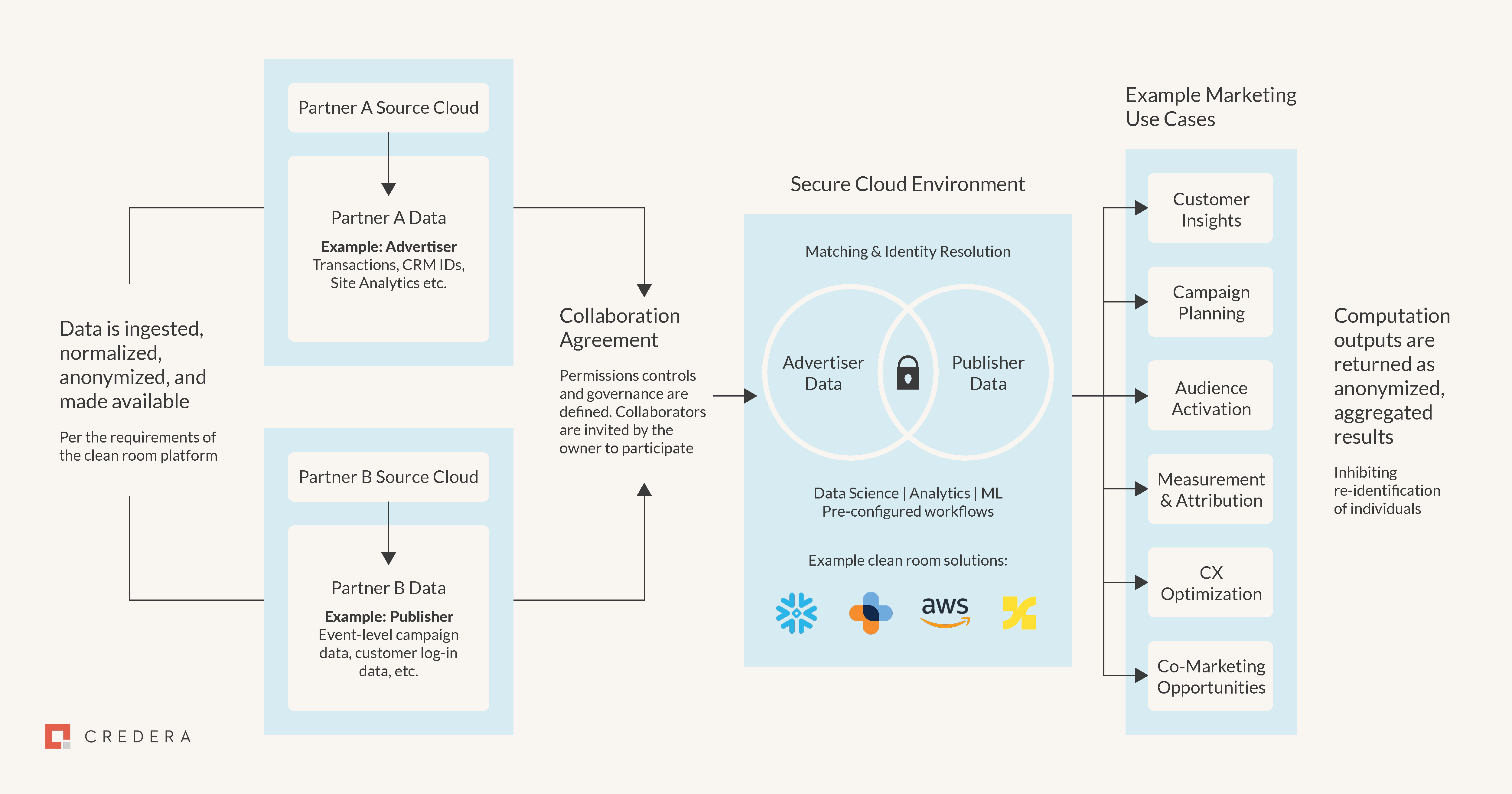Data
Feb 08, 2023
Data Clean Room Series Part 1: A Marketer’s Guide to Data Clean Rooms and Data Collaboration in a Privacy-First Landscape

One thing in the future of digital advertising is clear: privacy must come first. However, a wave of regulatory and tech changes impacting the advertising technology industry obscures the path to execution for privacy-first marketing strategies. Among all the solutions marketers are considering, data clean rooms may be one of the most promising for driving long-term business value; but they are also complex and require significant investment to set up and use, which can act as a high barrier to entry for many marketers.
In the first article of this series on data clean rooms we will explore: how to define data clean rooms and how they work, examples of how marketers can deliver business value through data collaboration, the data clean room provider landscape, and considerations for marketers when developing a data collaboration strategy.
Why Are We Talking About Data Clean Rooms?
Gartner predicts that by 2024, over 75% of the world’s population will have its personal information covered under modern privacy regulations.
These regulations govern how customer data is collected, stored, and used, including the General Data Protection Regulation (GDPR) in Europe, the U.S. state legislation already in place or scheduled to go into effect in 2023, and more on the horizon across the globe. The impact to marketers is compounded by additional changes within the industry, namely the deprecation of third-party identifiers (cookies and mobile identifiers) and growing fragmentation of AdTech driven by walled gardens.
As such, there is an urgency for marketers to identify new solutions for campaign planning, audience activation, measurement, and attribution that are privacy compliant, and deliver the same (or better) business outcomes.
Developing a strong first-party data strategy and understanding how to tap into second- and third-party data sources will be critical to any solutions to navigate the evolving privacy landscape. Yet in a recent survey by Credera of 200 global chief marketing officers, more than half (51%) said “we haven’t started yet” or “there’s a lot of work to be done” to re-focus efforts on first-party data collection.
Enter data clean rooms.
Marketers are prioritizing data clean room solutions in 2023 to maximize their use of first-party data and enable existing and new marketing use cases at scale—all while protecting the privacy of consumers. These secure environments are the foundation for data collaboration and provide the ability to tap into new datasets, unlock the total value of customer data, and deliver impactful, personalized customer experiences.
Data Clean Rooms Explained
What is a clean room and how does it work?
A data clean room is a secure, cloud-based environment designed for two or more parties to join datasets for analysis without compromising the privacy of consumers or the data owners. Sensitive data is never directly exchanged between partners, and results from the analyses are returned at the aggregate level so consumers cannot be identified individually.
With how data clean rooms have evolved in today’s landscape, many of the technical and legal barriers that previously existed for sharing data have been removed, thus opening the opportunity for new and stronger partnerships between brands built on increased transparency and trust.
Features and technical capabilities between data clean rooms will vary by provider, however the mechanics of these environments to enable privacy-compliant data collaboration can be summarized at a high-level:
Raw data is secured and encrypted, so no user-level data or personally identifiable information (PII) can be viewed or leave the data clean room environment.
Methods for data ingestion vary, from fully distributed (no data movement) to needing third-party infrastructure (such as a customer data platform [CDP]).
Data is joined, or matched, at a user level using either native methods or leveraging a third-party identity provider.
Varying privacy-protection measures are applied to prevent exposure or leakage of sensitive data at any point in the analysis; techniques vary by provider, including differential privacy, noise injection, encryption, etc.
Each collaborator defines the appropriate data access and rules for analysis, so data owners are in full control over who has access to their data and how it is being used; in most cases these permissions can be revoked at any time.
The net result is aggregate-level marketing data that can be used for insights, activation and/or measurement.

Data Clean Rooms: A Functional Overview
Data collaboration through data clean rooms unlocks access to new datasets for brands, publishers, and data providers, helping to fortify marketing activities against rapidly changing regulatory and AdTech landscapes. The availability of previously inaccessible data also opens the door for companies to explore entirely new use cases to deliver greater value to their customers.
How can data clean rooms create value?
Publishers, for example, have an opportunity to create incremental revenue streams and maintain investment in their platform(s) from advertisers by making their rich first-party data available through data clean rooms for smarter campaign planning and richer audience insights—without surrendering ownership of this data or control over how it can be used.
The consumer packaged goods (CPG) industry’s use of retail media networks is another great example of this mutually beneficial relationship: CPG companies that do not have a lot of first-party data can tap into retailers’ data clean rooms (such as Walmart Connect, Instacart, and most recently Albertsons) to securely access transaction data and perform closed-loop measurement on their advertising activity.
While the above scenarios are directly related to advertising, the use cases for data collaboration via data clean rooms extend beyond strictly targeting, activation, and measurement within paid media. Companies across industries such as automotive, travel, and entertainment are using access to more audience signals to fill the gaps in their understanding of the customer journey and create more personalized customer experiences.
The Data Clean Room Landscape
Data clean room solutions continue to proliferate, with newcomers regularly entering the market. Meanwhile, the more established players are continuing to evolve their offerings. In looking at the various options in the marketplace, most data clean room solutions currently fall into two main categories: closed ecosystems and neutral clean rooms.

Providers within each of the above categories could be further segmented based on their specific capabilities, architectures, and characteristics. We will explore each of these groups and their key players in more detail in a future blog post.
Two Ways Marketers Can Prepare for Data Collaboration in a Data Clean Room
1. Pulling Together the Right Stakeholders
The complexity of data clean rooms for marketers includes identifying and navigating internal resources from across the enterprise. Establishing and executing a data collaboration strategy requires the involvement of several stakeholder groups to enter privacy and regulatory-compliant agreements around sharing first-party data. Depending on the organization, this could include representation from teams such as marketing, legal, data science and marketing analytics, IT, product, and sales. If you are the data clean room owner, there are also aspects of productizing the offering and building platform capabilities that need to be addressed.
2. Preparing Your Data for Collaboration
Whether an organization is building its own data clean room solution or is entering a new collaboration hosted by another entity, marketers will need to prepare their first-party data to be used for joint analysis. While each provider has its own set of requirements and solutions, there are some common needs for ensuring data is in a location and format that can be used by data clean rooms:
Define and catalogue data sources: To start, teams need to select and define the data sources that contain the data they wish to use for collaboration.
Centralize and normalize data: With customer and campaign data likely coming from multiple sources it will need to be made accessible through a central location and process, typically prescribed by the data clean room provider, and normalized so it is in a format that can be matched to the other data within the environment.
Identify match keys: Before entering a new collaboration, participants will need to determine the identifiers (e.g., email addresses) that will be used within the data clean room to join the collective data.
Understand outputs: Marketers should ensure the outputs of the collaboration will be usable for their desired use cases, such as audience activation within media environments, and that the right connectors are in place.
Starting the Data Clean Room Journey
The value of data collaboration in a privacy-first landscape is evident, and there are numerous challenges for marketers to overcome to unlock the true potential of data clean rooms. Wrangling internal resources and first-party data is just the start. Even for the most data-savvy organizations, understanding the nuances of data clean rooms and building the appropriate solution amid uncertainty and continued privacy changes is a significant undertaking—especially up against the cookie-deprecation clock.
At Credera, we help clients break through challenges to maximize the value of their first-party data, establish data collaboration strategies, and implement data clean room solutions that will accelerate them toward delivering immediate value for their customers and business.
Stay tuned for the rest of our four-part series on data clean rooms: how marketers can use data clean rooms for privacy-first advertising, the opportunity for data monetization through data clean rooms, and guidance for marketers on the key players within the data clean room landscape and how to identify the right solution for their business.
Contact us at marketing@credera.com to learn more about how we can work together to establish your data collaboration strategy and identify the right data clean room solution for you.
Contact Us
Let's talk!
We're ready to help turn your biggest challenges into your biggest advantages.
Searching for a new career?
View job openings



